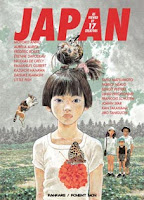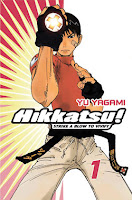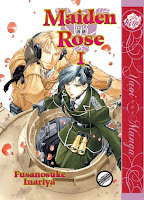My News and Reviews
Last week was the May 2011 Manga Moveable Feast which focusing on Mitsuru Adachi’s Cross Game. I posted a review for the first English volume (equivalent to the first three volumes published in Japan). Next month’s Feast will feature Kazuya Minekura’s Wild Adapter, which is one of my favorites. I’ve got a couple things planned for it that I’m excited about. Or at least I am amused by them.
Since it’s towards the end of the month, I am once again holding a manga giveaway: Oh, Ono! The winner will be announced Wednesday, so you’ve only a couple more days to enter to win a copy of the first volume of Natsume Ono’s first volume of Natsume Ono’s Gente: The People of Ristorante Paradiso from Viz Media. On a related note, Blogger is having issues posting comments. If you have trouble submitting, please send me an email with the comment and I’ll make sure you get entered in the contest.
I promised I would start posting links again to interesting things I’ve come across recently, so I would like to bring your attention to a great interview with Cathy Hirano: Catching Up with Cathy Hirano. Hirano is the translator for Haikasoru’s editions of Noriko Ogiwara’s Tales of the Magatama (which I haven’t read yet). She also translated the first two Moribito novels by Nahoko Uehashi which I adore (I’ve also reviewed both books). Hirano talks a bit about both series in the interview.
Quick Takes
 Andromeda Stories, Volumes 1-3 written by Ryu Mitsuse and illustrated by Keiko Takemiya. Ryu Mitsuse is an award winning science fiction author and Keiko Takemiya is an award winning mangaka who is no stranger to science fiction, so it is fabulous that the two of them were able to come together to collaborate on Andromeda Stories. I loved Takemiya’s artwork in this series. The character designs are attractive and the space imagery is gorgeous. The storyline might not be particularly innovative, and a few shortcuts in plot and characterization are necessary to tie everything together in three volumes, but I still found the manga to be engaging and I particularly liked the ending.
Andromeda Stories, Volumes 1-3 written by Ryu Mitsuse and illustrated by Keiko Takemiya. Ryu Mitsuse is an award winning science fiction author and Keiko Takemiya is an award winning mangaka who is no stranger to science fiction, so it is fabulous that the two of them were able to come together to collaborate on Andromeda Stories. I loved Takemiya’s artwork in this series. The character designs are attractive and the space imagery is gorgeous. The storyline might not be particularly innovative, and a few shortcuts in plot and characterization are necessary to tie everything together in three volumes, but I still found the manga to be engaging and I particularly liked the ending.
 Japan: As Viewed by 17 Creators by Various. Japan is an interesting, and I would say successful, joint effort between French and Japanese comics artists. The French contributors who were invited to visit Japan and their Japanese counterparts each penned a short comic offering their own unique perspective on the country. I wasn’t familiar with most of the creators involved with Japan, but I was very excited to see that both Moyoko Anno and Joann Sfar made contributions. The great thing about anthologies is that they allow readers to get acquainted with a number of different creators and potentially discover artists whose work they would like to follow. At least, I know that was the case for me reading Japan.
Japan: As Viewed by 17 Creators by Various. Japan is an interesting, and I would say successful, joint effort between French and Japanese comics artists. The French contributors who were invited to visit Japan and their Japanese counterparts each penned a short comic offering their own unique perspective on the country. I wasn’t familiar with most of the creators involved with Japan, but I was very excited to see that both Moyoko Anno and Joann Sfar made contributions. The great thing about anthologies is that they allow readers to get acquainted with a number of different creators and potentially discover artists whose work they would like to follow. At least, I know that was the case for me reading Japan.
 Maiden Rose, Volume 2 by Fusanosuke Inariya. I didn’t find the second volume to be quite as strong as the first, but it is still very good. More characters are introduced, but personally I would have liked to see those already established further developed. However, I am interested in seeing how Inariya will bring the new plotlines together. Although there is less graphic sex than in the first volume, the relationship between Taki and Klaus continues to be a very intense and complicated one. I have no idea how things are going to turn out for them and the war makes their relationship even more difficult. I hope we get to see more of this series (which I believe is currently up to four volumes in Japan) available in English.
Maiden Rose, Volume 2 by Fusanosuke Inariya. I didn’t find the second volume to be quite as strong as the first, but it is still very good. More characters are introduced, but personally I would have liked to see those already established further developed. However, I am interested in seeing how Inariya will bring the new plotlines together. Although there is less graphic sex than in the first volume, the relationship between Taki and Klaus continues to be a very intense and complicated one. I have no idea how things are going to turn out for them and the war makes their relationship even more difficult. I hope we get to see more of this series (which I believe is currently up to four volumes in Japan) available in English.
 Between the Folds directed by Vanessa Gould. Origami is a traditional Japanese artform that has become a world-wide phenomenon not only as art but as science. It is incredible what people are able to accomplish and create with a single piece of paper, from very simple shapes to extraordinarily complex ones. The field continues to evolve and develop and more and more practical applications are being discovered. Between the Folds examines and exhibits the work being done by artists, mathematicians, educators, and scientists; the variety and creativity is stunning and beautiful. The documentary is a fantastic and fascinating look at what origami is accomplishing today. I highly recommend watching it!
Between the Folds directed by Vanessa Gould. Origami is a traditional Japanese artform that has become a world-wide phenomenon not only as art but as science. It is incredible what people are able to accomplish and create with a single piece of paper, from very simple shapes to extraordinarily complex ones. The field continues to evolve and develop and more and more practical applications are being discovered. Between the Folds examines and exhibits the work being done by artists, mathematicians, educators, and scientists; the variety and creativity is stunning and beautiful. The documentary is a fantastic and fascinating look at what origami is accomplishing today. I highly recommend watching it!





